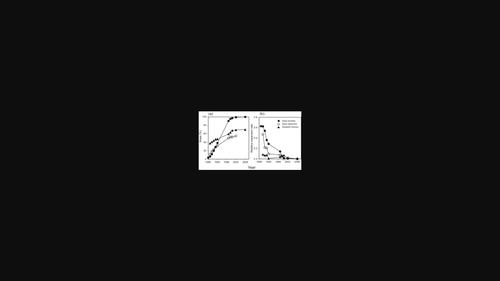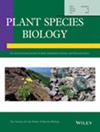温带阔叶林林下混交林矮竹群落克隆生长对矮竹竞争能力的影响
IF 1.3
4区 生物学
Q4 ECOLOGY
引用次数: 0
摘要
摘要研究了日本中部老山毛榉林中3种共生矮竹(Sasa borealis、Sasa nipponica和Sasaella ramosa)的克隆竞争。建立了一个10 m × 24 m的研究小区,研究这些树种的茎动态。与其他物种相比,北方莎草具有竞争优势。1988 ~ 2020年,竹竹以0.84 ~ 0.89 m/y的速度入侵其他竹种群;直到2003年,日本onica的入侵速度为0.17米/年。之后,S。随着S的入侵,nipponica开始以0.85 m/y的速度撤退。北极光到2020年。S。borealis在与S比赛前后没有变化。培。我们的结果表明,从S到S需要13.9 ~ 14.8年。北方真菌入侵S。Nipponica消失了。S的密度。Ramosa呈下降趋势,但并未从样地消失,以0.08 m/y的缓慢速度后退。北方莎竹几乎达到了其潜在最大竿密度,而其他两种竹没有达到。如果保持稳定的条件,S。北方竹将继续入侵、统治和消灭其他竹种。矮竹品种的最大密度、茎粗、寿命等生态性状是评价矮竹品种竞争力的良好指标。我们的研究结果表明,在很长一段时间内,森林林下的矮竹物种实际上被另一种竹物种所取代。本文章由计算机程序翻译,如有差异,请以英文原文为准。

Competitive ability of dwarf bamboo (Sasa borealis ) through long‐term clonal growth in mixed dwarf bamboo communities in the understory of a temperate deciduous forest
Abstract We investigated the clonal competition of three co‐occurring dwarf bamboo species, Sasa borealis , Sasa nipponica , and Sasaella ramosa , for 32 years in an old‐growth beech forest in central Japan. A study plot (10 m × 24 m) was established to examine the culm dynamics of these species. Sasa borealis had a competitive advantage over the other species. It invaded the other bamboo populations at a rate of 0.84–0.89 m/y from 1988 to 2020, while S . nipponica invaded at a rate of 0.17 m/y until 2003. After that, S . nipponica started to retreat at a rate of 0.85 m/y along with the invasion of S . borealis until 2020. The invasion rate of S . borealis did not change before and after the competition with S . nipponica . Our results showed that it would take 13.9–14.8 years from S . borealis invasion for S . nipponica to disappear. The density of S . ramosa decreased but it did not disappear from the plot because it retreated at a slow rate of 0.08 m/y. Sasa borealis almost achieved its potential maximum culm density, but the other two bamboo species did not. If stable conditions were maintained, S . borealis would continue to invade, dominate, and eliminate the other bamboo species. The ecological traits of dwarf bamboo species, such as the maximum density, size, and longevity of culms, are good indicators for assessing their competitiveness. Our findings demonstrate that dwarf bamboo species are actually replaced by another bamboo species in the forest understory during a long period.
求助全文
通过发布文献求助,成功后即可免费获取论文全文。
去求助
来源期刊

Plant Species Biology
生物-生态学
CiteScore
2.70
自引率
14.30%
发文量
36
审稿时长
>12 weeks
期刊介绍:
Plant Species Biology is published four times a year by The Society for the Study of Species Biology. Plant Species Biology publishes research manuscripts in the fields of population biology, pollination biology, evolutionary ecology, biosystematics, co-evolution, and any other related fields in biology. In addition to full length papers, the journal also includes short research papers as notes and comments. Invited articles may be accepted or occasion at the request of the Editorial Board. Manuscripts should contain new results of empirical and/or theoretical investigations concerning facts, processes, mechanisms or concepts of evolutionary as well as biological phenomena. Papers that are purely descriptive are not suitable for this journal. Notes & comments of the following contents will not be accepted for publication: Development of DNA markers. The journal is introducing ''Life history monographs of Japanese plant species''. The journal is dedicated to minimizing the time between submission, review and publication and to providing a high quality forum for original research in Plant Species Biology.
 求助内容:
求助内容: 应助结果提醒方式:
应助结果提醒方式:


